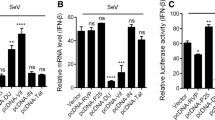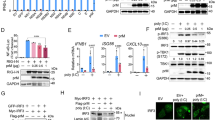Abstract
Japanese encephalitis virus (JEV) is a mosquito-borne virus and the major cause of viral encephalitis in Asia. NS1′, a 52-amino acid C-terminal extension of NS1, is generated with a -1 programmed ribosomal frameshift and is only present in members of the Japanese encephalitis serogroup of flaviviruses. Previous studies demonstrated that NS1′ plays a vital role in virulence, but the mechanism is unclear. In this study, an NS1′ defected (rG66A) virus was generated. We found that rG66A virus was less virulent than its parent virus (pSA14) in wild-type mice. However, similar mortality caused by the two viruses was observed in an IFNAR knockout mouse model. Moreover, we found that rG66A virus induced a greater type I interferon (IFN) response than that by pSA14, and JEV NS1′ significantly inhibited the production of IFN-β and IFN-stimulated genes. Taken together, our results reveal that NS1′ plays a vital role in blocking type I IFN production to help JEV evade antiviral immunity and benefit viral replication.




Similar content being viewed by others
References
Amorim JH, Alves RP, Boscardin SB, Ferreira LC (2014) The dengue virus non-structural 1 protein: risks and benefits. Virus Res 181:53–60
Ashour J, Laurent-Rolle M, Shi PY, Garcia-Sastre A (2009) NS5 of dengue virus mediates STAT2 binding and degradation. J Virol 83:5408–5418
Best SM (2017) The many faces of the flavivirus NS5 protein in antagonism of type I interferon signaling. J Virol 91:e01970-16
Blitvich BJ, Scanlon D, Shiell BJ, Mackenzie JS, Hall RA (1999) Identification and analysis of truncated and elongated species of the flavivirus NS1 protein. Virus Res 60:67–79
Dalrymple NA, Cimica V, Mackow ER (2015) Dengue virus NS proteins inhibit RIG-I/MAVS signaling by blocking TBK1/IRF3 phosphorylation: dengue virus serotype 1 NS4A Is a unique interferon-regulating virulence determinant. mBio 6:e00553-00515
Daniels BP, Snyder AG, Olsen TM, Orozco S, Oguin TH, Tait SWG, Martinez J, Gale M, Loo YM, Oberst A (2017) RIPK3 restricts viral pathogenesis via cell death-independent neuroinflammation. Cell 169:301–313
Firth AE, Atkins JF (2009) A conserved predicted pseudoknot in the NS2A-encoding sequence of West Nile and Japanese Encephalitis flaviviruses suggests NS1′ may derive from ribosomal frameshifting. Virol J 6:14
Ginsburg AS, Meghani A, Halstead SB, Yaich M (2017) Use of the live attenuated Japanese Encephalitis vaccine SA 14-14-2 in children: a review of safety and tolerability studies. Hum Vaccin Immunother 13:2222–2231
Grant A, Ponia SS, Tripathi S, Balasubramaniam V, Miorin L, Sourisseau M, Schwarz MC, Sanchez-Seco MP, Evans MJ, Best SM, Garcia-Sastre A (2016) Zika virus targets human STAT2 to inhibit type I interferon signaling. Cell Host Microbe 19:882–890
Igarashi A, Tanaka M, Morita K, Takasu T, Ahmed A, Akram DS, Waqar MA (1994) Detection of West Nile and Japanese Encephalitis viral genome sequences in cerebrospinal fluid from acute encephalitis cases in Karachi, Pakistan. Microbiol Immunol 38:827–830
Johansen CA, van den Hurk AF, Pyke AT, Zborowski P, Phillips DA, Mackenzie JS, Ritchie SA (2001) Entomological investigations of an outbreak of Japanese Encephalitis virus in the Torres Strait, Australia, in 1998. J Med Entomol 38:581–588
Mackenzie JS (2005) Emerging zoonotic encephalitis viruses: lessons from Southeast Asia and Oceania. J Neurovirol 11:434–440
Mackenzie JS, Gubler DJ, Petersen LR (2004) Emerging flaviviruses: the spread and resurgence of Japanese Encephalitis, West Nile and Dengue viruses. Nat Med 10:S98–S109
Melian EB, Hinzman E, Nagasaki T, Firth AE, Wills NM, Nouwens AS, Blitvich BJ, Leung J, Funk A, Atkins JF, Hall R, Khromykh AA (2010) NS1′ of flaviviruses in the Japanese Encephalitis virus serogroup is a product of ribosomal frameshifting and plays a role in viral neuroinvasiveness. J Virol 84:1641–1647
Mitchell CJ, Savage HM, Smith GC, Flood SP, Castro LT, Roppul M (1993) Japanese Encephalitis on Saipan: a survey of suspected mosquito vectors. Am J Trop Med Hyg 48:585–590
Morita K, Nabeshima T, Buerano CC (2015) Japanese encephalitis. Rev Sci Tech 34:441–452
Muller DA, Young PR (2013) The flavivirus NS1 protein: molecular and structural biology, immunology, role in pathogenesis and application as a diagnostic biomarker. Antiviral Res 98:192–208
Rastogi M, Sharma N, Singh SK (2016) Flavivirus NS1: a multifaceted enigmatic viral protein. Virol J 13:131
Snell LM, Brooks DG (2015) New insights into type I interferon and the immunopathogenesis of persistent viral infections. Curr Opin Immunol 34:91–98
Sucharit S, Surathin K, Shrestha SR (1989) Vectors of Japanese Encephalitis virus (JEV): species complexes of the vectors. Southeast Asian J Trop Med Public Health 20:611–621
Teijaro JR (2016) Type I interferons in viral control and immune regulation. Curr Opin Virol 16:31–40
Turtle L, Driver C (2018) Risk assessment for Japanese Encephalitis vaccination. Hum Vaccin Immunother 14:213–217
Turtle L, Solomon T (2018) Japanese encephalitis—the prospects for new treatments. Nat Rev Neurol 14:298–313
Unni SK, Ruzek D, Chhatbar C, Mishra R, Johri MK, Singh SK (2011) Japanese encephalitis virus: from genome to infectome. Microb Infect 13:312–321
Urosevic N (2003) Is flavivirus resistance interferon type I-independent? Immunol Cell Biol 81:224–229
van den Hurk AF, Ritchie SA, Mackenzie JS (2009) Ecology and geographical expansion of Japanese Encephalitis virus. Annu Rev Entomol 54:17–35
Wang J, Li X, Gu J, Fan Y, Zhao P, Cao R, Chen P (2015) The A66G back mutation in NS2A of JEV SA14-14-2 strain contributes to production of NS1′ protein and the secreted NS1′ can be used for diagnostic biomarker for virulent virus infection. Infect Genet Evol 36:116–125
Ye Q, Li XF, Zhao H, Li SH, Deng YQ, Cao RY, Song KY, Wang HJ, Hua RH, Yu YX, Zhou X, Qin ED, Qin CF (2012) A single nucleotide mutation in NS2A of Japanese encephalitis-live vaccine virus (SA14-14-2) ablates NS1′ formation and contributes to attenuation. J Gen Virol 93:1959–1964
Young LB, Melian EB, Khromykh AA (2013) NS1′ colocalizes with NS1 and can substitute for NS1 in West Nile virus replication. J Virol 87:9384–9390
Young LB, Melian EB, Setoh YX, Young PR, Khromykh AA (2015) Last 20 aa of the West Nile virus NS1′ protein are responsible for its retention in cells and the formation of unique heat-stable dimers. J Gen Virol 96:1042–1054
Zhang HL, Ye HQ, Liu SQ, Deng CL, Li XD, Shi PY, Zhang B (2017) West Nile Virus NS1 antagonizes interferon beta production by targeting RIG-I and MDA5. J Virol 91:e02396-16
Acknowledgements
This work was supported by the National Key Research and Development Program of China (2016YFD0500407), National Natural Science Foundation of China (31502065 and 31572517), and Fundamental Research Funds for the Central Universities (2013PY051, 2662016Q003, and 2662015PY083).
Author information
Authors and Affiliations
Contributions
JY, SBC, YFS, MC, and HCC conceived and designed the experiments. DYZ, FJ, QYL, LPZ, ZC, and ZKZ performed the experiments. DYZ analyzed the data. DYZ and JY wrote the manuscript and prepared the Figures. JY and SBC checked and finalized the manuscript. All authors read and approved the final manuscript.
Corresponding author
Ethics declarations
Conflict of interest
The authors declare no conflict of interests. All authors read and approved the final manuscript.
Animal and Human Rights Statement
Animal experiments in this study were approved by the Scientific Ethics Committee of Huazhong Agricultural University (permit number HZAUMO-2017-016).
Electronic supplementary material
Below is the link to the electronic supplementary material.
Rights and permissions
About this article
Cite this article
Zhou, D., Jia, F., Li, Q. et al. Japanese Encephalitis Virus NS1′ Protein Antagonizes Interferon Beta Production. Virol. Sin. 33, 515–523 (2018). https://doi.org/10.1007/s12250-018-0067-5
Received:
Accepted:
Published:
Issue Date:
DOI: https://doi.org/10.1007/s12250-018-0067-5




